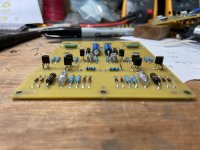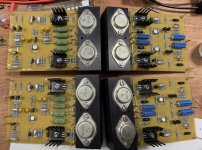Hi Stanislav1957,
Did you mean to post that to a different thread? It doesn't look anything like a NAP250 (other than the LTP and VAS current sources sharing the same reference)....
Cheers,
Jeff.
And than it is not similar? The only difference is the use of a more advanced voltage amplifier with Miller effect compensation.
And where a similar theme? Could you tell me please
Last edited:
The NAP250 circuit has a couple of features which make it (to my mind) quite different:
1) a heavily unbalanced LTP,
2) a quasi-complementary Baxandal output stage,
3) phase-correction networks on the two drivers
There are no doubt other more modern topologies that perform better, but the oddness of Julian Vereker's work, and the fact that the result sounds remarkably good given what appear to be significant limitations, are some of the things that make it so interesting.
Cheers,
Jeff.
1) a heavily unbalanced LTP,
2) a quasi-complementary Baxandal output stage,
3) phase-correction networks on the two drivers
There are no doubt other more modern topologies that perform better, but the oddness of Julian Vereker's work, and the fact that the result sounds remarkably good given what appear to be significant limitations, are some of the things that make it so interesting.
Cheers,
Jeff.
The NAP250 circuit has a couple of features which make it (to my mind) quite different:
1) a heavily unbalanced LTP,
2) a quasi-complementary Baxandal output stage,
3) phase-correction networks on the two drivers
There are no doubt other more modern topologies that perform better, but the oddness of Julian Vereker's work, and the fact that the result sounds remarkably good given what appear to be significant limitations, are some of the things that make it so interesting.
Cheers,
Jeff.
And why in the 21st century quasi complementary output
Fly to Colorado and ride the train from Durango to Silverton. You'll be riding in a coach made in the late 1800s, pulled by a steam engine built in the 1920s. Some things are just cool.
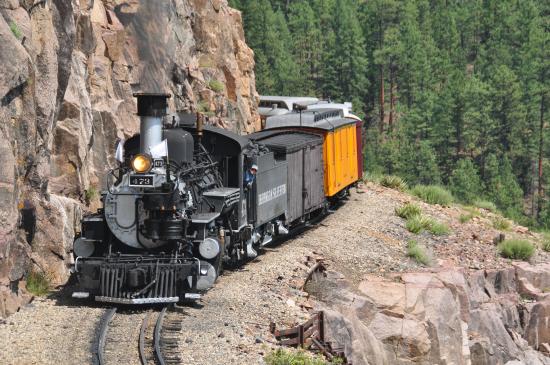

Go to the Lord Veliky Novgorod to dig ancient excavations, find letters and read the living history from the 7th century to the 13th century.Fly to Colorado and ride the train from Durango to Silverton. You'll be riding in a coach made in the late 1800s, pulled by a steam engine built in the 1920s. Some things are just cool.

Last edited:
Приезжайте. Посетите Новгород, Ладогу Старую Руссу.,Сходите в Кремль Новгородский ,зайдите в Святую Софию . Всегда рады туристам.Stanislav, would love to visit that place, beautiful architecture !!🙂
Arrive. Visit Novgorod, Ladoga And Staraya Russa.,Go to the Novgorod Kremlin, go to St. Sophia . Tourists are always welcome.
Great stuff sir, and it would be nice to try some real Russian vodka !!😀
Have to wait 5 more years for pension, want to go before 60 !!
Have to wait 5 more years for pension, want to go before 60 !!
Great stuff sir, and it would be nice to try some real Russian vodka !!😀
Have to wait 5 more years for pension, want to go before 60 !!
Russian vodka, Yes Tatar pilaf and rye bread! Guests are welcome.
Русская водка,да татарский плов и ржаной хлеб.Приезжайте.Гостям рады.
Veliky Novgorod does look fantastic. I've always meant to take a cruise from Copenhagen to St. Petersburg; looks like this would make a fine day-trip from St. Petersburg.
Some options for the front-end regulation:
Differential. (This is essentially the Naim regulator without current limiting and powering only the front-end.)
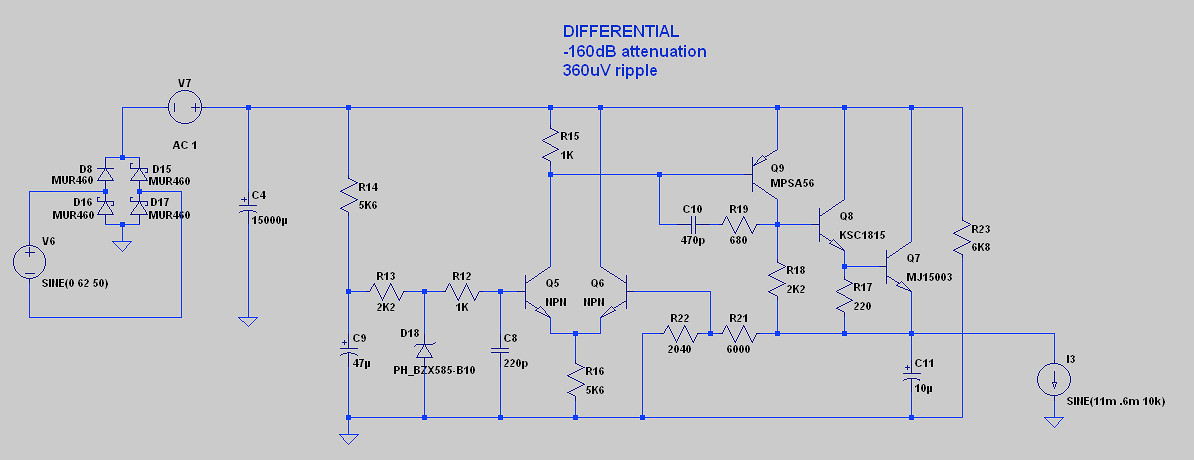
Shunt.

C-multiplier.
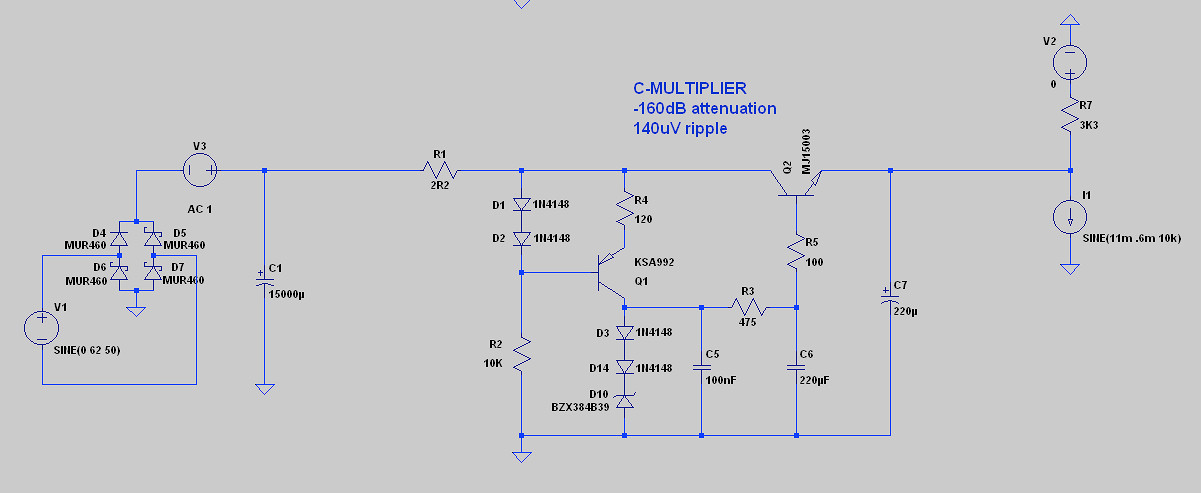
Maida.
1,200uV of ripple. Disqualified.
Jung Super Regulator.
Clearly better performance than any of the above, but gave SPICE fits trying to find the operating point. Probably over my pay-grade; disqualified.
I'm late to this but I've been looking to clone a Naim for decades so this is what a search brought up. In looking at the block diagrams at what Naim calls their new DR discrete regulation circuit, it follows what Jung used in the Super Regulator circuit. There Jung uses the regulated output to power all the references used for the regulator itself. DR Power Amplifiers | Naim Audio
Seems to me that Naim has made what many people asked of the Super Reg..can it be scaled for power amplification. Maybe someone at Diyaudio will come up with a generic DR or Power Amp capable Super Reg.
I don't think you need to go as far as the Jung topology for a power amp. You can fix the 3 Naim dirty references by:
1) give the Zener voltage reference a CCS
2) give the differential a current mirror
3) flip the VAS so it references ground instead of the dirty rail
I posted a design in this thread somewhere that does (3) and adds a CCS for the differential.
We've been discussing a regulator over on the JamJar thread in the Pass Labs forum which does (1) and (2). It looks something like this:

Note that this is only a Darlington output rather than a triple because it's only for the amp's front-end. The current mirror appears to work better than the CCS I used in the inverted Naim regulator. The CCS for the Zener is also a big win.
Cheers,
Jeff.
1) give the Zener voltage reference a CCS
2) give the differential a current mirror
3) flip the VAS so it references ground instead of the dirty rail
I posted a design in this thread somewhere that does (3) and adds a CCS for the differential.
We've been discussing a regulator over on the JamJar thread in the Pass Labs forum which does (1) and (2). It looks something like this:
Note that this is only a Darlington output rather than a triple because it's only for the amp's front-end. The current mirror appears to work better than the CCS I used in the inverted Naim regulator. The CCS for the Zener is also a big win.
Cheers,
Jeff.
Attachments
I am building this amplifier but I cannot find 1N5621 except on ebay for a ridiculous price of 6.36£ each. Can anyone please suggest an alternative?
I bought BDY58 from France for 10£ each so 6.36 for a diode seems excessive.
Thanks
I bought BDY58 from France for 10£ each so 6.36 for a diode seems excessive.
Thanks
We don't actually need the voltage rating of the 1N5621; that just happens to be the one Mouser had in stock at the time. 1N5617, 1N5619 and 1N5623 will all do nicely:
1N5617GP-E3/54 Vishay Semiconductors | Mouser Ireland
FR203 through FR207 would also work, although may exhibit harsher clipping driving a reactive load if you're likely to do such a thing:
RL207-B Rectron | Mouser Ireland
1N5617GP-E3/54 Vishay Semiconductors | Mouser Ireland
FR203 through FR207 would also work, although may exhibit harsher clipping driving a reactive load if you're likely to do such a thing:
RL207-B Rectron | Mouser Ireland
We don't actually need the voltage rating of the 1N5621; that just happens to be the one Mouser had in stock at the time. 1N5617, 1N5619 and 1N5623 will all do nicely:
1N5617GP-E3/54 Vishay Semiconductors | Mouser Ireland
FR203 through FR207 would also work, although may exhibit harsher clipping driving a reactive load if you're likely to do such a thing:
RL207-B Rectron | Mouser Ireland
Thank you Jeff, replacements ordered, Appreciate your help
Sajjad
Hi Jeff
Just getting round to ordering bits for the inverted regional board that I don't have and am a bit confused about the 10iF caps, they are normally 13 ohms impedance on Naim boards but you quote 1.4r on the BOM what part number did you use here?
Cheers Geoff
Just getting round to ordering bits for the inverted regional board that I don't have and am a bit confused about the 10iF caps, they are normally 13 ohms impedance on Naim boards but you quote 1.4r on the BOM what part number did you use here?
Cheers Geoff
Hi Geoff,
Did you see the posts on the Group Buy thread about the missing resistors between the rails and the LPT CCS transistors?
For the cap, I used MAL213829109E3 Vishay / BC Components | Mouser Ireland. They're 11 ohms; the 1.7R on the schematic is the bare minimum I could get the sim to behave at, but that's probably confusing so I've changed the schematic (and stuffing guide) to read 11R.
Cheers,
Jeff.


Did you see the posts on the Group Buy thread about the missing resistors between the rails and the LPT CCS transistors?
For the cap, I used MAL213829109E3 Vishay / BC Components | Mouser Ireland. They're 11 ohms; the 1.7R on the schematic is the bare minimum I could get the sim to behave at, but that's probably confusing so I've changed the schematic (and stuffing guide) to read 11R.
Cheers,
Jeff.
Attachments
- Home
- Amplifiers
- Solid State
- NAP250 clone
